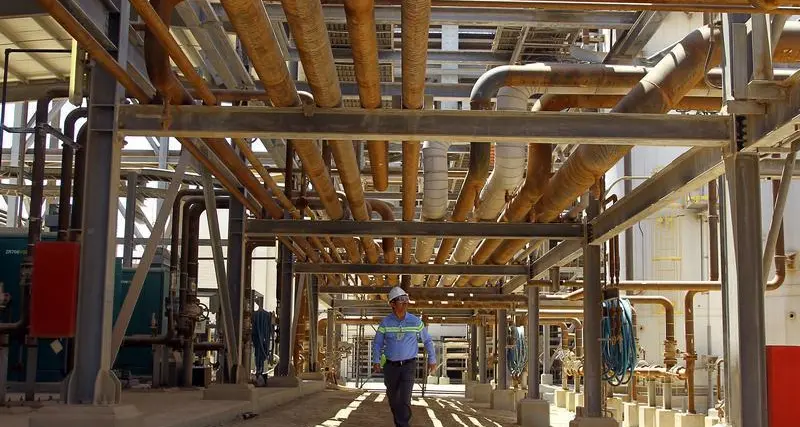PHOTO
(John Kemp is a Reuters market analyst. The views expressed are his own)
LONDON- Lower oil prices are starting to rebalance the oil market by slowing the rise in U.S. crude output and encouraging Saudi Arabia and its allies to extend production cuts through the end of 2019.
U.S. crude production rose 241,000 barrels per day (bpd) to 11.905 million bpd in March from February, according to the U.S. Energy Information Administration (“Petroleum Supply Monthly”, EIA, May 2019).
U.S. crude output during the first three months of the year was up 1.575 million bpd compared with the same period a year earlier, but the growth rate has slowed from 1.920 million bpd in the third quarter of 2018.
Onshore production from the Lower 48 states excluding federal waters in the Gulf of Mexico was up 1.425 million bpd year-on-year in the first quarter, down from an increase of 1.817 million bpd in the third quarter of 2018.
Falling prices since the start of the fourth quarter, renewed since the end of April, have slowed the rate of new drilling and fresh well completions in the major shale plays.
The number of rigs drilling for oil fell to just 800 at the end of May, down by almost 10 percent from a current-cycle peak of 888 in November 2018, according to oilfield services company Baker Hughes.
Experience suggests changes in wellhead prices filter through to changes in the number of rigs drilling for oil with a lag of 3-4 months, and to changes in production with a lag of around 9-12 months.
The full impact of recent price declines will therefore continue to filter through into slower production growth in the second half of 2019 and into the first part of 2020.
Lower prices are also pushing Saudi Arabia and its allies within the expanded OPEC+ group of oil exporting countries to extend their current production cuts for the second half of the year.
The combination of slower supply growth from U.S. shale and continued restraint by Saudi Arabia and its allies should eliminate the prospective oversupply of oil later in 2019 and 2020.
PRICE CONVERGENCE
In the last month, Brent spot prices and calendar spreads have been sending seemingly contradictory signals about the outlook for the oil market in the second half of the year.
Slumping spot prices since late April have indicated traders are concerned about the market becoming oversupplied and a big build in inventories.
In contrast, six-month calendar spreads surged deeper into backwardation, implying traders are worried about undersupply and a further drawdown in stocks.
Much of the concern about production is concentrated in nearby months, while the outlook further forward is dominated by fears about consumption.
Spread tightness was concentrated in July-August futures and reflected concerns about availability, while Russia's exports remain disrupted by pipeline contamination and North Sea platforms undergo maintenance.
As the July contract expired and the six-month spread rolled forward to August-February, the backwardation shrank sharply from more than $4 per barrel to less than $2 and has come under further pressure.
Spot prices and spreads must eventually converge. So far, that convergence is coming from a softening of the spreads pointing to greater concern about consumption rather than production in the second half of the year.
Traders are increasingly concerned a potential slowdown in consumption growth could leave the market oversupplied later in the year, unless shale output slows further and OPEC+ extends production cuts.
Spot prices and spreads are moving to enforce an adjustment to slower production growth, just as they did in the fourth quarter of 2018.
RECESSION IS COMING
Consumption concerns stem from a bigger fear about a sharp slowdown in the global economy that could ripple through the freight transportation and manufacturing sectors to hit oil demand.
Recent economic indicators show manufacturing activity and freight movements around the world flat-lining or falling after strong growth in 2017 and 2018.
Recession risks are the highest since the Great Recession of 2008/09 and are already higher than before the recessions of 1991 and 2001, according to the New York Fed's yield-curve model.
U.S. interest rate traders now expect the Federal Reserve to cut interest rates by almost three-quarters of a percentage point by the start of 2020, according to futures markets.
The OECD's leading economic indicator has fallen to its lowest for almost a decade and is at a level that since 1970 has always signalled an imminent recession.
In China, the world's largest oil importer, manufacturers have reported a significant loss of momentum since the middle of 2018 and business activity has fallen in four of the last six months.
As a result, oil prices have tumbled to adjust to the increased risk of a recession biting into expected consumption later in the year and early 2020.
If the risk of recession recedes, prices will rise again, but for the moment traders are sending a signal to Saudi Arabia and U.S. shale producers on the need to curb output growth in the face of a likely economic slowdown.
(Editing by Jan Harvey) ((john.kemp@thomsonreuters.com and on twitter @JKempEnergy))












